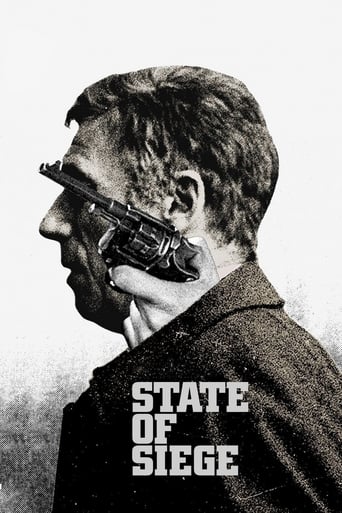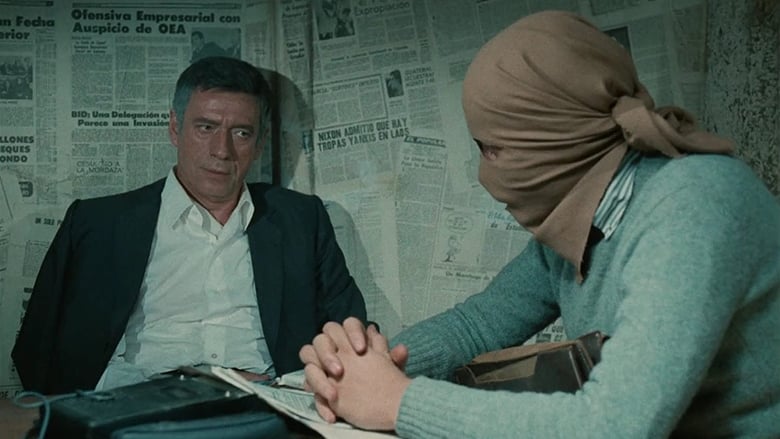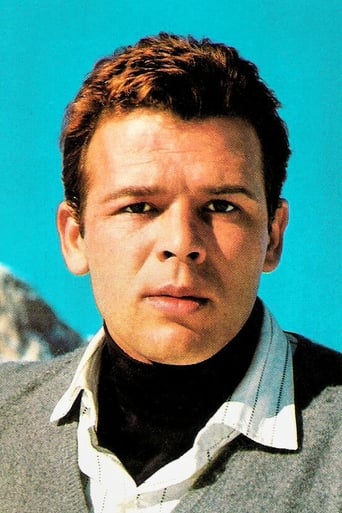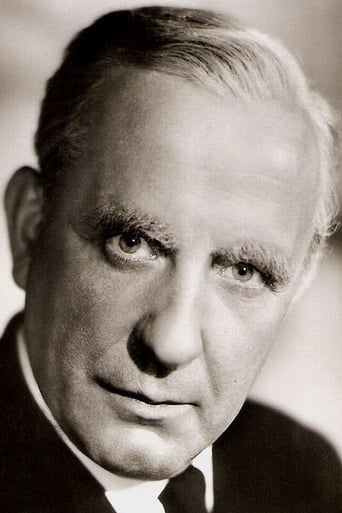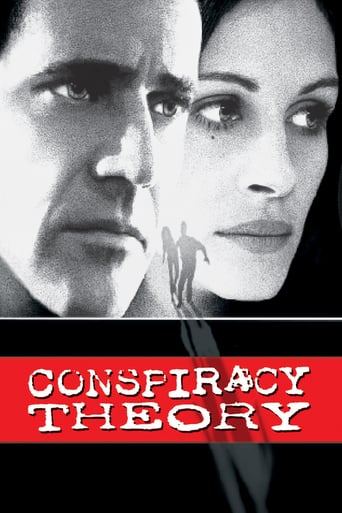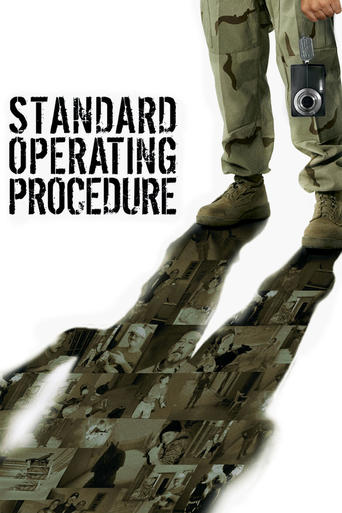State of Siege (1972)
Using the interrogation of a US counterinsurgency agent as a backdrop, the film explores the consequences of the struggle between Uruguay's government and the leftist Tupamaro guerrillas.
Watch Trailer
Cast


Similar titles
Reviews
An absolute waste of money
A different way of telling a story
Although it has its amusing moments, in eneral the plot does not convince.
If you're interested in the topic at hand, you should just watch it and judge yourself because the reviews have gone very biased by people that didn't even watch it and just hate (or love) the creator. I liked it, it was well written, narrated, and directed and it was about a topic that interests me.
Forty-three years after its release 'Sate of Siege' has not lost its bite.Uruguay has moved on his the days of the 'Tupermaros, an urban guerrilla group, who opposed the 'democratic' government in Montevideo, supported by the US government sponsored terrorist training of the military and the policy. Yves Montand is Philip Michael Santore, a police man from Chicago, who is sent under the cover of the Agency for International Development, in the hot spots of Latin America in the 1960s and early 70s, to beef up the armed forces and police in Santo Domingo, Brazil and Uruguay. In reality, Santore teaches torture--electric shock, water boarding, black sites and the like, to combat as he says Communists and rescue Christian civilization from left-wing radicals in opposition to authoritarian rule. We didn't need to await George W Bush for the US to fight 'terrorism', since the measures of torture and coercion were already in place. And are still taught today in the Western Hemisphere Institute for Security (once known as the School of the Americas). The name has changed but not the mission. The deft hand of Costa-Garvas advances the narrative; it is a matter-of-fact rendering of a kidnapping; it has that telegraphic style of reporting, with communiques issued daily on the state of health of the kidnapped three (a Brazilian diplomat, Santore and another American working under cover at the US embassy). And then, there are the demands: you release our comrades and allow them to seek asylum in a third country. But the government doesn't budge. It--surprise--is unaware that the likes of Santore is in the country, doing his training in torture...wink, wink. Questions are raised in parliament by the left and center parties, but they are ignored by denial. The Nixon administration wouldn't rescue Santore by pressuring Montevideo to meet the Tupamaros demands. At the same time, the chief of police, played by the underrated Renato Salvatore, undertake to find the guerrillas and put them out of action or make them disappeared. The music by Theodakis sustains the tension. In the end Santore's body is found in the boot of an automobile. The film opens with a funeral mass in the Cathedral, and from there, in a long flashback...the story of Santore is told. He is replaced, but at the airport as the new 'AID' man descends with wife and two children, a Tupamaro watches...for no matter how many urban guerilla had been rounded up torture, killed or...the network has survived. Costa-Garva's camera is records: he has used it effectively in 'Z' as he did in 'State of Siege'. Although times have changed, not so America's repressive methods as the world's policeman. Somewhat weakened by the phony Bush war in Korea and the stupidity of Libya and idiocy in Syria, let alone the quagmire in Afghanistan. 'State of Siege' ends on a confident tone since the US is still losing in Vietnam. And Brazil and Uruguay is a panel in Che Guevara's call for one, two or Vietnam to challenge American imperialism. On one hand, the film is a chapter in history; on the other, it is powerful recall that little has changed in the nature of US imperial pretensions.
I learned of this movie by way of the book "Who Killed Bobby?" by Shane O'Sullivan- a book which strongly suggests that there was a conspiracy in the assassination of Robert F. Kennedy. On pages 413-414 of this book, he describes the OPS (Office of Public Safety) which was run by the CIA from 1962 to 1975. It's mission was to train US ally police forces and military officers to improve their effectiveness. During these years, the OPS trained 7,500 senior officers at it's US facilities- this is shown in the film 'State of Siege'- and more than half a million foreign police overseas. One of the central aims of the OPS was to train local officials to effectively deal with "terrorist" threats from the left (and subsequently keep in power/put in power forces on the right). Techniques in torture, assassination, and all the other 'dirty tricks' the CIA (at this time, at least) was famous for, were taught to conservative, right-wing allies in a total of 47 nations. In the case of a retired police chief from Richmond, Indiana- Dan Mitrione (played by Yves Montand in State of Siege)- he took things a bit too far- granted he had his hands full with the Tupamaros. According to O'Sullivan, Mitrione "built a soundproofed room in the cellar of his house (in Montevideo, Uruguay) and demonstrated torture techniques to selected Uruguayan police officers, using beggars taken off the street, some of whom died during the sessions." pg. 414. Mitrone was kidnapped on July 31st, 1970, and 10 days later his body was found in a car. "Mr. Mitrione's devoted service to the cause of peaceful progress in an orderly world will remain as an example for free men everywhere." said a White House press release, and Frank Sinatra and Jerry Lewis visited Richmond, IN to stage a benefit show. Meanwhile, back in Montevideo, the former chief of police intelligence, Alejandro Otero, "confirmed that Mitrione had used 'violent techniques of torture....and a psychology to create despair, such as playing a tape in the next room of women and children screaming and telling prisoners that it was his family being tortured.'" (p.414) These despicable facts are not presented in State of Siege, it should be noted. Otero was a CIA agent, and he spoke only because a close friend of his was a Tupamaros sympathizer...he was demoted for speaking out. This is a fine film and it's very understandable that it's extremely hard to find in the US. It's fair to say that 99% of Americans have no idea what the CIA was up to from 1962-1975...it would be more accurate to say CIA officers were up to because, from what I can tell, there were quite a few 'loose canons' in the CIA at that time...and some of them were willing to do whatever it took to fight political forces emerging from the left (including, of course, forces within the US). See one David Morales as such an example of a CIA loose canon (although it is very hard to get information on him, O'Sullivan says that Morales later went to Montevideo and "took his own murderous revenge on the Tupamaros". It's important to view State of Siege in it's proper historical context: sure you can talk about the cold war, but it's also about an institution infused with right-wing ideology (the CIA) hellbent on getting police and military forces in as many other allies prepared to defeat any leftist challenges to the status quo (ie. in the vast majority of cases, a conservative government). If a government fell into the hands of a leftist, then it had to be taken back for fear that it might fall into the Soviet sphere of influence. But in the end, we need to look at how conservative governments aid "big business" (see 'Missing' for more on this), because in the final analysis, it all comes down to who gets what...money. This film is to radically to the left and airs Americas dirty laundry too much...no wonder it's difficult to find...It's like "Punishment Park" by Peter Watkins. Fortunately now, in this internet age, we can get both films...go ogle 'rap id share (one wo rd) title of film 'etat de siege' and sub titles 'all subs' (one wo rd).
A superior film in every way. I last viewed it Stateside, dubbed into English, on a public-television broadcast perhaps 25 years ago. It appears available on VHS at collectors' prices, but I'd very much prefer to see it treated on DVD as was lately done to "Z," remastered, subtitled, and with as many bonus features as possible.You may recognize more of Costa-Gavras's stock players besides Yves Montand. One noticeable stylistic difference: Given the grimness of its scenario "Z" occasionally bemuses, but State of Siege does not, even when Theodorakis's theme song tries to distract you.This said, for its narrative style and documentary look, is State of Siege a representation of a true story or merely "based upon"? At least this American chooses not to judge without having the unalloyed facts arrayed before him. The film did succeed in the sense that it made me want to learn more about its subject.The long out-of-print companion book contains Solinas's screenplay, stills from the film, a statement by Montand, and supplemental published materials presumably used in research with an extensive bibliography. Perhaps its most revealing component is the transcribed interview by Nicholas Ray of Solinas and Costa-Gavras, which mentions among other things tape recordings of the captive on whom Montand's character is based. Yet it is Costa-Gavras' final statement on the choice of filming location that is at once funny, sad and chilling in hindsight, and provides ample proof that times change.
In the early 70's, in Uruguay, the revolutionary group Tupamaro kidnaps an American trainer of torture and the Brazilian consul, and through the interrogation of the abducted American, the big picture of Uruguay (and other Latin America countries) is reported."État de Siege" is a testimony of the history of Latin America in the 70's, during my childhood and adolescence. All the democratic governments elected by people were discharged through coup d'état by military dictatorships supported by the American government, the police and military forces trained in tortures by American advisors, student and union leaderships destroyed and revolutionary groups unsuccessfully fighting against the dictatorial regime. The fantastic director Costa Gravas exposes this serious wound in Latin America and this denunciation shall never be forgotten by the next generations. This movie remains amazingly real and important, sometimes recalling a documentary. Only this month this film was released on DVD in Brazil, and it is a worthwhile investment. My vote is ten.Title (Brazil): 'Estado de Sítio" ("State of Siege")

